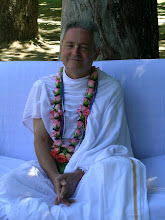PART I
In the sacred
occasion of the departure of Bhaktivedanta Swami Shrila Prabhupada, we pray Shri Krishna to empower us with strength so that we could carry in our hearts the example of His extraordinary life, character, deeds and works forever. Those who were able to witness His life and teachings, had the greatest luck to testify the
changes in their lives and in the lives of so many
people.
These transformations are the great events from which we
can draw an inexhaustible inspiration: Shrila Prabhupada gave us the
opportunity to live in the spiritual awareness. The path traced by Him is followed
by hundreds of thousands of people, and the most favored are those
who welcomed Him in the heart, dedicating their service to the
realization of His dream, that is make available the love of God to
as many people as possible regardless of race, creed, culture, social
position, politics or religion.
36 years ago Shrila Prabhupada
left His physical body and this material world to return to where He
came from, the spiritual universe. We pray Bhagavan Shri Krishna to
give us the purity to be able to celebrate His glories properly. By
celebrating His glories we become aware of his greatness, and
becoming aware of the greatness of a pure devotee of the Lord, we can
experience the greatness of God. In this way, practicing the nine
paths of Bhakti, we can realize our divine nature and become purified from the distortions of psychic structure and its conditionings.
We take this special opportunity to increase our sincere
attachment to the lotus feet of Shrila Prabhupada, to humbly serve
His teachings and His way of life so as to bring us closer to Him and to
Shri Krishna through the nine paths of love mentioned before.
Shrila
Prabhupada allowed hundreds of thousands of people to transform their
lives by changing their vision, allowing them to get rid of the
identification with the material structure that covers their eternal Self. Shrila Prabhupada gave the possibility to understand the difference
between the spiritual Self, the body and the mind and
to realize the divine potential of each person regardless of age,
gender, social status and culture. The term Acarya means exemplary. Through His example and model of
life, Shrila Prabhupada made the teachings of the
Shastras feasible.
A person can take the Bhagavad-gita, read some sublime
passages and reflect: "How nice it would be to live like that,
but who is able to? I would not be capable of doing that for sure."
We need a model, an example, there must be someone who lives the
teachings of the Bhagavad-gita constantly, faithfully, coherently,
and joyfully. The sacred work becomes a person, and the highest aspirations become applicable in our lives. It is exactly what
happened to all of us. Why? Because Shrila Prabhupada experienced
Bhakti so intensely and joyfully, no matter what life presented to
Him in terms of ordeals, difficulties and obstacles to overcome. His
relying on Krishna at all times without ever becoming fatalistic
allowed this great Acarya to live in this world in pure spiritual
consciousness. Faith is not a fatalism, it is an evolutionary
creativity for searching the best solution for the existential
problems; if we direct our efforts towards the spiritual evolution
with commitment and faith, such solution will appear as Paramatma in
the heart, as well as through the expert guidance of the Spiritual Master in the outer
world.














